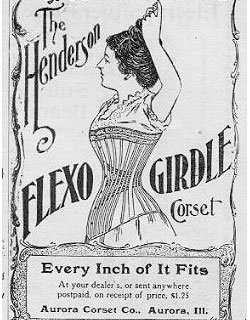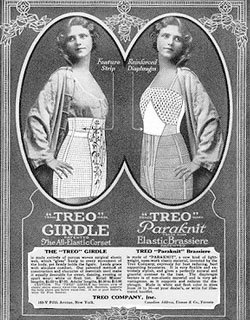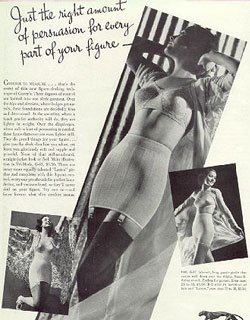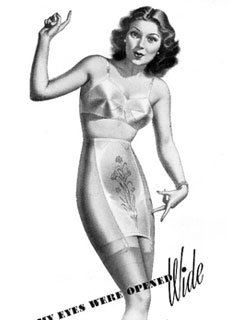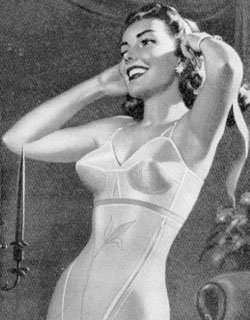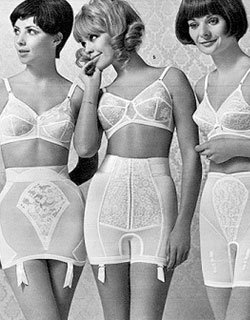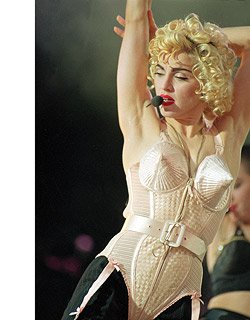Men Go for It
By Any Name
Besides Girdle
'Shapewear' Sounds
Better to a Vain Guy;
Mr. Verdi in a Bind
By CHERYL LU-LIEN TAN
March 15, 2008; Page A1
When Jeff Lewis had trouble buttoning his trousers recently, he didn't go on a diet or hit the gym. He reached for a new device: "bodyshaping" underwear. Basically, a girdle.
"It took an inch-and-a-half off my waist," says Mr. Lewis, a 26-year-old events coordinator in Phoenix. "It gave me an instant ego boost."
While men's underwear makers go out of their way to avoid the "G-word," a growing number of labels are launching elasticized "shapewear," "bodywear," "support boxers" and other beer-belly-constricting undergarments for men. Men are starting to ease into the idea.
Saks Fifth Avenue in January started carrying a new line from 2(X)ist featuring spandex briefs and tank tops designed to have a trimming effect. In the fall, Los Angeles underwear brand Go Softwear will roll out a men's "Waist Eliminator," which has a waistband that extends up to mid-torso in order to hold the tummy in. Last month, Andrew Christian, a men's underwear line sold in boutiques such as Fred Segal in Los Angeles, introduced the Flashback Butt Lifting Technology Boxer -- a stretchy bodyshaping brief with a built-in elastic sling to lift and perk up the back side by "up to an inch."
Retailers say a younger generation of men is more open to wearing body-sculpting undergarments today than their fathers were. But for men to wear girdles actually isn't a new phenomenon. In the early 19th century, some fashionable men in England were known to wear them. Drawings circulated in high society at the time portrayed men as dandies laced up in corsets. In 1899, an ad for Madame Dowding, a ladies' corsetiere in London, also advertised versions for men, including a model called "The Marlboro." In high fashion a century later, avant-garde designer Jean-Paul Gaultier created some corsets for men in the late 1990s.
In the mainstream, over the past 15 years, men have grown comfortable wearing tight-fitting shirts and compression shorts as athletic wear and to improve circulation or aerodynamics. Many men in their 20s and 30s put a greater emphasis on grooming and appearance today and are requesting body-hugging underwear specifically for slimming purposes.
Indeed, sales growth in men's underwear is outpacing that of women's. Last year, sales of men's underwear in the U.S. rose 7.8% from 2005 to reach 1.1 billion units, according to market-researcher NPD Group. By comparison, women's intimate-apparel unit sales rose 2.3% to reach 1.5 billion in the same period.
Robert Verdi, 39, says he began craving a so-called mirdle, or man-girdle, recently after starting to develop a "muffin top." "I'm now at that weird age where I'm starting to have a little bit of a spare tire, that midsection squish," says Mr. Verdi, a New York stylist and TV personality. Feeling self-conscious while prepping for a recent date, Mr. Verdi took scissors to a pair of high-waisted women's Spanx so it fit him like an elongated tube-top beneath his fitted shirt and slacks. "I felt like I was wearing an Ace bandage, but I definitely looked flatter," he says.
It wasn't long ago that even the idea of a man girdle was taboo. When Go Softwear introduced its first "Waist Eliminator" in 1997, "it was almost like a joke," says Greg Olvera, the label's president. The company discontinued the line after two years because of poor sales.
In the mid-1990s, the Undergear label, which has a catalog and a Web site, sold two styles of shapers for men -- a stretchy, slimming tank top and a boxer brief that the brand touted as "problem solvers" designed to "redefine trouble spots." The products remained largely niche items until two years ago, when sales of bodyshapers began rising, the company says. It declined to provide sales figures.
But it wasn't until recently that such items have become more common in mainstream department and specialty stores. Spanx says it is considering a male version of its shapewear.
Nevertheless, male-girdle marketing can be tricky. Since Solidea USA last year created a line of slimming undies for men, it has been careful to call its girdle-like gear "support boxers" or "compression shorts," says Max Hauer, co-owner of the company.
In Japan, where there has been a small market for such products among men, companies have been just as cautious. Wacoal last year started selling a male girdle called the ex walker in Japan, but chose to focus its marketing on the product's health benefits. Marketing materials note that the fabric and construction are designed to help the wearer's muscles work harder while walking.
Demand for slimming undergarments, including compression pantyhose, is also being fueled by fashion trends. European-style slimmer-cut clothes for men have become big in the American market. Last year, premium denim makers pushed skinny, figure-hugging jeans for men. "In men's clothes right now, slim is in -- everything has a much more fitted silhouette, from the tapered leg to narrow dress shirts," says Richard Gualtieri, director for men's fashion merchandising at Lord & Taylor. He notes that men have been seeking out more figure-hugging underwear, where "there's some stretch to it that helps lift and keep things in place a little bit more."
Early adopters still risk ridicule, however. Daniel Hernandez, 24, this year bought an Undergear bodyshaping brief after packing on a few pounds over the holidays. On the very first night he wore his new girdle, flattered by compliments about his new waistline, he lifted his shirt to show off the garment.
"One guy was, like, 'Oh, what, are you, grandma now?'" says Mr. Hernandez, a public-relations executive in the tourism business in New York.
Dan Uram, a 37-year-old aspiring actor in Beverly Hills, Calif., bought a Solidea body shaper last year to give him an edge in auditions as well as in dating. He says the men's body shapers are part of men's liberation. They help level the playing field for men and women. "Lots of women wear girdles," he observes.
Still, there can be concern over having to explain the shaper in intimate situations. Mr. Verdi, who wore the cut-up women's shaper, says he worried about what his date would think of it. The date, however, didn't mind, he says.
story and images below from wsj.com
By Any Name
Besides Girdle
'Shapewear' Sounds
Better to a Vain Guy;
Mr. Verdi in a Bind
By CHERYL LU-LIEN TAN
March 15, 2008; Page A1
When Jeff Lewis had trouble buttoning his trousers recently, he didn't go on a diet or hit the gym. He reached for a new device: "bodyshaping" underwear. Basically, a girdle.
"It took an inch-and-a-half off my waist," says Mr. Lewis, a 26-year-old events coordinator in Phoenix. "It gave me an instant ego boost."
While men's underwear makers go out of their way to avoid the "G-word," a growing number of labels are launching elasticized "shapewear," "bodywear," "support boxers" and other beer-belly-constricting undergarments for men. Men are starting to ease into the idea.
Saks Fifth Avenue in January started carrying a new line from 2(X)ist featuring spandex briefs and tank tops designed to have a trimming effect. In the fall, Los Angeles underwear brand Go Softwear will roll out a men's "Waist Eliminator," which has a waistband that extends up to mid-torso in order to hold the tummy in. Last month, Andrew Christian, a men's underwear line sold in boutiques such as Fred Segal in Los Angeles, introduced the Flashback Butt Lifting Technology Boxer -- a stretchy bodyshaping brief with a built-in elastic sling to lift and perk up the back side by "up to an inch."
Retailers say a younger generation of men is more open to wearing body-sculpting undergarments today than their fathers were. But for men to wear girdles actually isn't a new phenomenon. In the early 19th century, some fashionable men in England were known to wear them. Drawings circulated in high society at the time portrayed men as dandies laced up in corsets. In 1899, an ad for Madame Dowding, a ladies' corsetiere in London, also advertised versions for men, including a model called "The Marlboro." In high fashion a century later, avant-garde designer Jean-Paul Gaultier created some corsets for men in the late 1990s.
In the mainstream, over the past 15 years, men have grown comfortable wearing tight-fitting shirts and compression shorts as athletic wear and to improve circulation or aerodynamics. Many men in their 20s and 30s put a greater emphasis on grooming and appearance today and are requesting body-hugging underwear specifically for slimming purposes.
Indeed, sales growth in men's underwear is outpacing that of women's. Last year, sales of men's underwear in the U.S. rose 7.8% from 2005 to reach 1.1 billion units, according to market-researcher NPD Group. By comparison, women's intimate-apparel unit sales rose 2.3% to reach 1.5 billion in the same period.
Robert Verdi, 39, says he began craving a so-called mirdle, or man-girdle, recently after starting to develop a "muffin top." "I'm now at that weird age where I'm starting to have a little bit of a spare tire, that midsection squish," says Mr. Verdi, a New York stylist and TV personality. Feeling self-conscious while prepping for a recent date, Mr. Verdi took scissors to a pair of high-waisted women's Spanx so it fit him like an elongated tube-top beneath his fitted shirt and slacks. "I felt like I was wearing an Ace bandage, but I definitely looked flatter," he says.
It wasn't long ago that even the idea of a man girdle was taboo. When Go Softwear introduced its first "Waist Eliminator" in 1997, "it was almost like a joke," says Greg Olvera, the label's president. The company discontinued the line after two years because of poor sales.
In the mid-1990s, the Undergear label, which has a catalog and a Web site, sold two styles of shapers for men -- a stretchy, slimming tank top and a boxer brief that the brand touted as "problem solvers" designed to "redefine trouble spots." The products remained largely niche items until two years ago, when sales of bodyshapers began rising, the company says. It declined to provide sales figures.
But it wasn't until recently that such items have become more common in mainstream department and specialty stores. Spanx says it is considering a male version of its shapewear.
Nevertheless, male-girdle marketing can be tricky. Since Solidea USA last year created a line of slimming undies for men, it has been careful to call its girdle-like gear "support boxers" or "compression shorts," says Max Hauer, co-owner of the company.
In Japan, where there has been a small market for such products among men, companies have been just as cautious. Wacoal last year started selling a male girdle called the ex walker in Japan, but chose to focus its marketing on the product's health benefits. Marketing materials note that the fabric and construction are designed to help the wearer's muscles work harder while walking.
Demand for slimming undergarments, including compression pantyhose, is also being fueled by fashion trends. European-style slimmer-cut clothes for men have become big in the American market. Last year, premium denim makers pushed skinny, figure-hugging jeans for men. "In men's clothes right now, slim is in -- everything has a much more fitted silhouette, from the tapered leg to narrow dress shirts," says Richard Gualtieri, director for men's fashion merchandising at Lord & Taylor. He notes that men have been seeking out more figure-hugging underwear, where "there's some stretch to it that helps lift and keep things in place a little bit more."
Early adopters still risk ridicule, however. Daniel Hernandez, 24, this year bought an Undergear bodyshaping brief after packing on a few pounds over the holidays. On the very first night he wore his new girdle, flattered by compliments about his new waistline, he lifted his shirt to show off the garment.
"One guy was, like, 'Oh, what, are you, grandma now?'" says Mr. Hernandez, a public-relations executive in the tourism business in New York.
Dan Uram, a 37-year-old aspiring actor in Beverly Hills, Calif., bought a Solidea body shaper last year to give him an edge in auditions as well as in dating. He says the men's body shapers are part of men's liberation. They help level the playing field for men and women. "Lots of women wear girdles," he observes.
Still, there can be concern over having to explain the shaper in intimate situations. Mr. Verdi, who wore the cut-up women's shaper, says he worried about what his date would think of it. The date, however, didn't mind, he says.
story and images below from wsj.com


